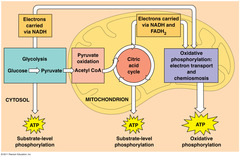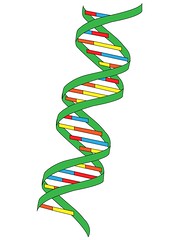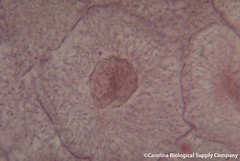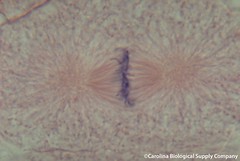Cells Flashcards
Terms : Hide Images [1]
| 7857695978 | adenosine triphosphate (ATP) | compound used by cells to store and release energy |  | 0 |
| 7857695979 | aerobic | process that requires oxygen | 1 | |
| 7857695980 | anaerobic | process that does not require oxygen | 2 | |
| 7857695981 | anaphase | phase of mitosis in which the chromosomes separate and move to opposite ends of the cell |  | 3 |
| 7857695982 | apoptosis | process of programmed cell death | 4 | |
| 7857695983 | asexual reproduction | process of reproduction involving a single parent that results in offspring that are genetically identical to the parent |  | 5 |
| 7857695984 | ATP synthase | cluster of proteins that span the cell membrane and allow hydrogen ions (H+) to pass through it | 6 | |
| 7857695985 | Autotroph | organism that is able to capture energy from sunlight or chemicals and use it to produce its own food from inorganic compounds; also called a producer |  | 7 |
| 7857695986 | binary fission | type of asexual reproduction in which an organism replicates its DNA and divides in half, producing two identical daughter cells |  | 8 |
| 7857695987 | Calorie | measure of heat energy in food; equivalent to 1000 calories | 9 | |
| 7857695988 | Calvin cycle | light-independent reactions of photosynthesis in which energy from ATP and NADPH is used to build high-energy compounds such as sugar |  | 10 |
| 7857695989 | Cancer | disorder in which some of the body's cells lose the ability to control growth | 11 | |
| 7857695990 | Cell | basic unit of all forms of life |  | 12 |
| 7857695991 | cell division | by which a cell divides into two new daughter cells |  | 13 |
| 7857695992 | cell membrane | thin, flexible barrier that surrounds all cells; regulates what enters and leaves the cell |  | 14 |
| 7857695993 | cell theory | fundamental concept of biology that states that all living things are composed of cells; that cells are the basic units of structure and function in living things; and that new cells are produced from existing cells | 15 | |
| 7857695994 | cell wall | strong, supporting layer around the cell membrane in some cells |  | 16 |
| 7857695995 | cellular respiration | process that releases energy by breaking down glucose and other food molecules in the presence of oxygen |  | 17 |
| 7857695996 | centriole | structure in an animal cell that helps to organize cell division |  | 18 |
| 7857695997 | centromere | region of a chromosome where the two sister chromatids attach |  | 19 |
| 7857695998 | chlorophyll | principal pigment of plants and other photosynthetic organisms | 20 | |
| 7857695999 | chloroplast | organelle found in cells of plants and some other organisms that captures the energy from sunlight and converts it into chemical energy |  | 21 |
| 7857696000 | chromatid | one of two identical "sister" parts of a duplicated chromosome |  | 22 |
| 7857696001 | chromatin | substance found in eukaryotic chromosomes that consists of DNA tightly coiled around histones |  | 23 |
| 7857696002 | chromosome | threadlike structure within the nucleus that contains genetic information that is passed from one generation to the next |  | 24 |
| 7857696003 | cyclin | a regulatory molecule that induces mitosis when its levels increase | 25 | |
| 7857696004 | cytokinesis | division of the cytoplasm to form two separate daughter cells |  | 26 |
| 7857696005 | cytoplasm | fluid portion of the cell outside the nucleus |  | 27 |
| 7857696006 | cytoskeleton | network of protein filaments in a eukaryotic cell that gives the cell its shape and internal organization and is involved in movement |  | 28 |
| 7857696007 | differentiation | process in which cells become specialized in structure and function |  | 29 |
| 7857696008 | diffusion | process by which particles tend to move from an area where they are more concentrated to an area where they are less concentrated |  | 30 |
| 7857696009 | DNA (deoxyribonucleic acid) | the macromolecule containing genetic information |  | 31 |
| 7857696010 | electron transport chain | series of electron carrier proteins that shuttle high-energy electrons during ATP-generating reactions | 32 | |
| 7857696011 | embryo | developing stage of a multicellular organism |  | 33 |
| 7857696012 | endergonic reaction | a chemical reaction that requires an input of energy |  | 34 |
| 7857696013 | endoplasmic reticulum | internal membrane system found in eukaryotic cells; place where lipid components of the cell membrane are assembled |  | 35 |
| 7857696014 | eukaryote | organism whose cells contain a nucleus | 36 | |
| 7857696015 | exergonic reaction | a chemical reaction that releases energy |  | 37 |
| 7857696016 | facilitated diffusion | process of diffusion in which molecules pass across the membrane through cell membrane channels |  | 38 |
| 7857696017 | FAD | small energy carrier molecule | 39 | |
| 7857696018 | Fermentation | process by which cells release energy in the absence of oxygen |  | 40 |
| 7857696019 | G0 phase | resting phase during which the cell does not prepare to divide | 41 | |
| 7857696020 | G1 phase | phase of the cell cycle in which the cell carries out normal functions and prepares to replicate its DNA | 42 | |
| 7857696021 | G2 phase | phase of the cell cycle in which the cell prepares to begin mitosis | 43 | |
| 7857696022 | Gene | sequence of DNA that codes for a protein and thus determines a trait; factor that is passed from parent to offspring | 44 | |
| 7857696023 | genetic information | set of genes that code for all the proteins needed by an organism | 45 | |
| 7857696024 | glycolysis | first set of reactions in cellular respiration in which a molecule of glucose is broken into two molecules of pyruvic acid |  | 46 |
| 7857696025 | Golgi apparatus | organelle in cells that modifies, sorts, and packages proteins and other materials from the endoplasmic reticulum for storage in the cell or release outside the cell |  | 47 |
| 7857696026 | growth factor | a regulatory molecule that stimulates or inhibits the rate of cell division |  | 48 |
| 7857696027 | heterotroph | organism that obtains food by consuming other living things; also called a consumer |  | 49 |
| 7857696028 | histone | protein that associates with DNA to form chromosomes | 50 | |
| 7857696029 | homeostasis | relatively constant internal physical and chemical conditions that organisms maintain |  | 51 |
| 7857696030 | hypertonic | when comparing two solutions, the solution with the greater concentration of solutes |  | 52 |
| 7857696031 | hypotonic | when comparing two solutions, the solution with the lesser concentration of solutes |  | 53 |
| 7857696032 | interphase | period of the cell cycle between cell divisions |  | 54 |
| 7857696033 | isotonic | the concentration of two solutions is the same |  | 55 |
| 7857696034 | Krebs cycle | second stage of cellular respiration in which pyruvic acid is broken down into carbon dioxide in a series of energy-extracting reactions |  | 56 |
| 7857696035 | light-dependent reactions | set of reactions in photosynthesis that use energy from light to produce ATP and NADPH |  | 57 |
| 7857696036 | light-independent reactions | set of reactions in photosynthesis that do not require light; energy from ATP and NADPH is used to build high-energy compounds such as sugar; also called the Calvin cycle |  | 58 |
| 7857696037 | lipid bilayer | flexible double-layered sheet that makes up the cell membrane and forms a barrier between the cell and its surroundings |  | 59 |
| 7857696038 | lysosome | cell organelle that breaks down lipids, carbohydrates, and proteins into small molecules that can used by the rest of the cell |  | 60 |
| 7857696039 | Metaphase | phase of mitosis where the chromosomes line up in the middle of the cell |  | 61 |
| 7857696040 | Mitochondria | cell organelles that convert the chemical energy stored in food into compounds that are more convenient for the cell to use |  | 62 |
| 7857696041 | Mitosis | part of eukaryotic cell division during which the cell nucleus divides |  | 63 |
| 7857696042 | Multicellular | consisting of many cells |  | 64 |
| 7857696043 | Multipotent | with limited potential to develop into many types of differentiated cells |  | 65 |
| 7857696044 | NAD (nicotinamide adenine dinucleotide) | electron carrier involved in glycolysis | 66 | |
| 7857696045 | NADPH (nicotinamide adenine dinucleotide phosphate) | carrier molecule that transfers high-energy electrons from chlorophyll to other molecules | 67 | |
| 7857696046 | nuclear envelope | membrane around the nucleus |  | 68 |
| 7857696047 | nuclear pores | holes in the membrane of the nucleus through which substances enter and exit |  | 69 |
| 7857696048 | nucleolus | small structure found in the cell nucleus containing protein and nucleic acids |  | 70 |
| 7857696049 | nucleus | in cells, structure that contains the cell's genetic material in the form of DNA | 71 | |
| 7857696050 | organelle | specialized structure that performs important cellular functions within a eukaryotic cell |  | 72 |
| 7857696051 | osmosis | diffusion of water through a selectively permeable membrane |  | 73 |
| 7857696052 | osmotic pressure | pressure that must be applied to prevent osmotic movement across a selectively permeable membrane | 74 | |
| 7857696053 | photosynthesis | process used by plants and other autotrophs to capture light energy and use it to power chemical reactions that convert carbon dioxide and water into oxygen | 75 | |
| 7857696054 | photosystem | cluster of chlorophyll and proteins found in thylakoids | 76 | |
| 7857696055 | pigment | light-absorbing molecule used by plants to gather the sun's energy | 77 | |
| 7857696056 | pluripotent | cells that are capable of developing into most, but not all, of the body's cell types |  | 78 |
| 7857696057 | prokaryote | unicellular organism that lacks a nucleus |  | 79 |
| 7857696058 | prophase | first and longest phase of mitosis in which the genetic material inside the nucleus condenses and the chromosomes become visible |  | 80 |
| 7857696059 | ribosome | cell organelle consisting of RNA and protein found throughout the cytoplasm in a cell; the site of protein synthesis |  | 81 |
| 7857696060 | S phase | phase of the cell cycle during which DNA is replicated | 82 | |
| 7857696061 | selectively permeable | property of biological membranes that allows some substances to pass across the membrane while others cannot |  | 83 |
| 7857696062 | stem cell | unspecialized cell that can give rise to one or more types of specialized cells |  | 84 |
| 7857696063 | stroma | fluid portion of the chloroplast; outside the thylakoids |  | 85 |
| 7857696064 | telophase | phase of mitosis in which the distinct individual chromosomes begin to spread out into a tangle of chromatin |  | 86 |
| 7857696065 | thylakoid | saclike photosynthetic membranes found in chloroplasts |  | 87 |
| 7857696066 | tissue | group of similar cells that perform a particular function | 88 | |
| 7857696067 | totipotent | cells that are able to develop into any type of cell found in the body |  | 89 |
| 7857696068 | tumor | mass of rapidly dividing cells that can damage surrounding tissue |  | 90 |
| 7857696069 | unicellular | consisting of one cell |  | 91 |
| 7857696070 | vacuole | cell organelle that stores materials such as water, salts, proteins, and carbohydrates |  | 92 |
